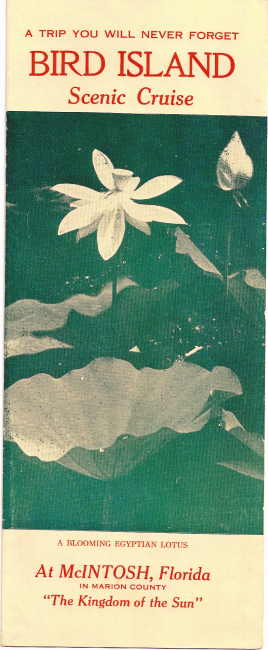
 |
Bird Island Cruise |
|
Home Attractions List Books Poster Gallery Timeline
|

Orange Lake (the lake that Marjorie Kinnan Rawling's famed Cross Creek crosses to) has long been an important rookery for the White Ibis, a bird once so hunted for its plumage that, in 1910, the Audubon Society was moved to buy most of the lake's Bird Island and establish the first Audubon sanctuary in the United States there to protect them. Audubon fought off the plume hunters, but bird watchers were welcomed. M.N. Gist of McIntosh, a small town on the lake's western shore, acted as Audubon's sanctuary Warden. He, along with his partner Davis, established a Wild Fowl Farm in the area and started offering regular tourist tours of the lake -- the Bird Island Cruise. For 50 cents you could board one of their boats for a forty-five minute tour of Orange Lake, featuring the rookery at Bird Island as well as the strange formations described by one brochure as "Naturally Formed, FLOATING ISLANDS, featured by 'Ripley's Believe It Or Not.'" These were thick floating clumps of living vegetation that detached from the shallow lake bottom and went sailing around on their own, gathering other plants, birds, and animals as they went. They could get as big as ten feet thick, support tree growth, and be sturdy enough to walk on. Naturalist Don McKay was guide and narrator on the cruise and seems to have taken over the cruise operation in later years. The tour seemed to operate primarily in the 1930's and 1940's. Davis & Gist offered the Wild Fowl Farm for sale ("suitable for parts or tourist attraction") in 1948, and were still selling birds and trying to sell the farm at least two years later. Although the attraction had ceased operating formally as a business, McKay seems to have continued giving tours on a charter or informal basis through at least the mid-1950's.
Orange Lake wasn't always there to be toured, however. Sinkhole activity in the 1950's drained about half the lake. Finally, concrete, old cars, and other junk was dumped into the hole to help clog the leak and allow the water level to recover. More recently, in late 2000, another sinkhole opened and nearly drained the lake by 90%. Although it has again recovered somewhat, Orange Lake is still not what it used to be. Not much is left of the floating islands, either. Efforts to control infestations of the non-native hydrilla in the 1990's, as well as clearance by the Florida Game and Fresh Water Fish Commission of the islands to assist fishermen in 1998, have left them few and far between. Bird Island is still there, however, and it is still owned by the Florida Audubon Society, so at least the birds (what birds remain, species vary as changing water levels in the lake change the type of habitat) are still protected. And that's what started the whole thing in the first place. |
|
Note: the attractions profiled on this site are no longer in business. Return To Florida's Lost Tourist Attractions
Brochure image from the author's collection.
This site Copyright (c) 1997-2011 by Robert H. Brown
|